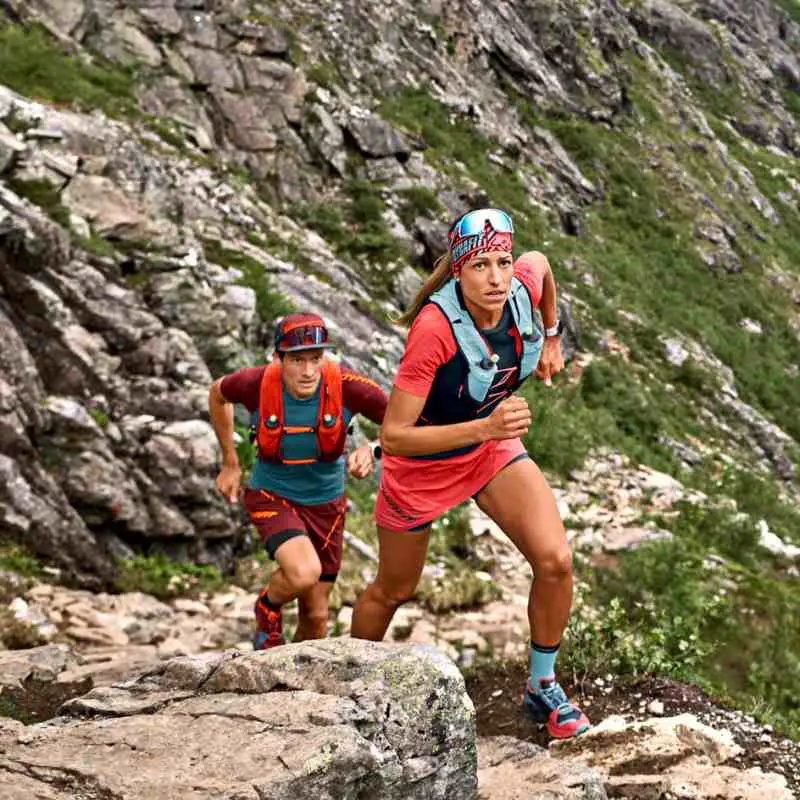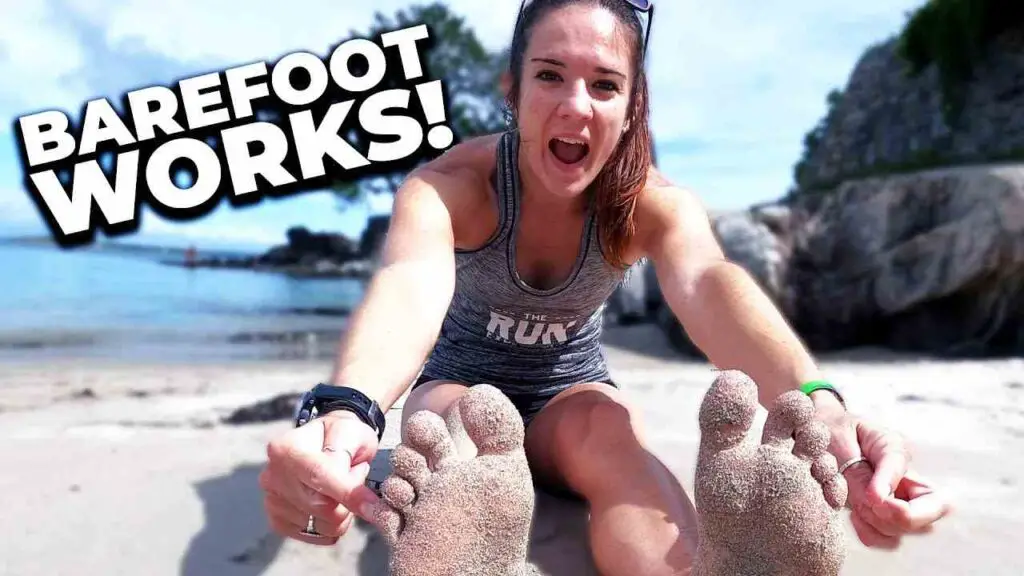Trail running is an exciting sport that combines adventure and fitness in the best way possible. It takes you off the usual routes and into nature’s playground, where every step presents a new challenge and each mile tests your endurance. But like any sport, it has its ups and downs. One common concern for both seasoned trail runners and beginners is: “Is trail running bad for your knees?”
In this article, we’ll dive into this question, looking at how trail running affects your knees compared to road running, and discussing common knee injuries trail runners might face. We’ll also cover ways to protect your knees, including effective warm-up and cool-down routines, and the importance of conditioning and strength training for preventing injuries.
Understanding Knee Anatomy and Function

The knee is pretty amazing when you think about it! It’s built to handle all sorts of movements and carry our weight, especially when we’re out on the trails. Knowing how it’s put together is key if you want to understand how trail running affects it.
Bones and Articulations: At the heart of the knee are three bones: the femur (thigh bone), tibia (shin bone), and patella (kneecap). These bones meet at two main articulations: the tibiofemoral joint, where the tibia meets the femur, and the patellofemoral joint, where the patella meets the femur.
Cartilage: Ensuring smooth movement, the ends of these bones are covered with articular cartilage, a slick, cushioning surface. Additionally, the meniscus, a type of cartilage, acts as a shock absorber between the femur and tibia.
Ligaments: Binding these bones together are robust bands known as ligaments. The knee boasts four major ligaments: the anterior cruciate ligament (ACL) and posterior cruciate ligament (PCL) which cross each other in the center, and the medial collateral ligament (MCL) and lateral collateral ligament (LCL) which run along the inner and outer aspects of the knee.
Muscles and Tendons: Surrounding the knee are muscles that facilitate movement, connected to the bones by tendons. The contraction of these muscles pulls on the tendons, enabling the knee to move.
Function: The primary functions of the knee include supporting the body’s weight, enabling leg movement, and providing stability and balance. It operates like a hinge joint, allowing for bending and straightening within a single plane.
SHOP FOR THE TRAIL RUNNING SHOES ON AMAZON
When we really get how the knee works, it helps us see just how much it has to deal with during trail running. Plus, it reminds us how crucial it is to take care of our knees if we want to keep hitting the trails for years to come.
Impact of Trail Running on Knee Health
Trail running, with its natural terrain and scenic routes, is a popular form of exercise that offers numerous benefits. However, its impact on knee health has been a topic of debate among enthusiasts and experts alike. Let’s dive into some recent studies to see what they have to say about the impact of trail running on knee health.
Studies on Knee Health and Running:
- A study published in BMJ Open aimed to understand the trajectory of knee health in runners, focusing on those with and without a history of knee surgery. It compared knee joint structural features on MRI and knee symptoms at baseline and after four years, exploring the relationship between training load and changes in knee joint structure and symptoms.
- The research highlighted by Health.com suggests that trail running not only promotes joint health but also strengthens and preserves the joints. This is supported by preliminary studies indicating that running on trails can be beneficial for the knees.
- According to longevity research from Stanford, recreational runners have a lower prevalence of knee and hip osteoarthritis compared to sedentary non-runners. Competitive runners showed an even more significant reduction in knee and hip osteoarthritis prevalence.
- The Cleveland Clinic has reported that running does not cause arthritis, and the body, including the knees, recovers from the effects of running. A large survey of marathon runners found that increased running did not raise their risk of arthritis and may even lower it.
Temporary Changes in Cartilage and Joint Fluids: While running doesn’t necessarily lead to arthritis, it can cause temporary changes in cartilage and joint fluids. These changes are part of the body’s natural response to the physical activity of running. The compression and decompression of the knee joint during running facilitate the movement of fluids, which helps in the delivery of nutrients to the cartilage. This process can lead to temporary changes in the cartilage’s thickness and volume, which are generally reversible and part of the knee’s adaptation to the stress of running.
SHOP FOR THE KNEE BRACE ON AMAZON
In conclusion, trail running, when done with proper technique and preparation, does not inherently damage the knees or lead to arthritis. On the contrary, it can be beneficial for knee health, strengthening the joints and potentially reducing the risk of osteoarthritis.
Trail vs. Road Running
When comparing trail running to road running, each has its own set of benefits and risks that cater to different preferences and fitness goals. Here’s a detailed look at how they stack up against each other:
Trail Running:
- Softer Surfaces: Trails typically have softer surfaces like dirt or grass, which are easier on the joints and can reduce the risk of impact-related injuries.
- Varied Terrain: The uneven and varied terrain of trails challenges different muscle groups, enhances balance, and improves agility.
- Scenic Environment: Trail running often takes place in more scenic settings, which can be mentally refreshing and reduce stress.
- Less Pollution: Trails are usually away from urban pollution, providing cleaner air to breathe during your run.
- Risk of Accidents: The uneven terrain can increase the risk of trips, falls, and related injuries such as ankle sprains.
Road Running:
- Convenience: Roads are more accessible for most people, allowing for more consistent training without the need to travel far.
- Pace and Timing: The flat and even surface of roads is conducive to maintaining a consistent pace and is preferred for speed work or timed runs.
- Social Aspect: Road running events and groups are more common, offering a social component that many runners enjoy.
- Higher Impact: Running on harder surfaces like asphalt can lead to a higher risk of repetitive stress injuries.
- Air Pollution: Running in urban areas can expose runners to higher levels of air pollution, which may affect respiratory health.
Ultimately, the choice between trail and road running depends on personal preferences, goals, and considerations of health and safety. Some runners may prefer the challenge and tranquility of the trails, while others may opt for the convenience and speed of road running.
Proper Running Technique
Maintaining proper form while running is essential for minimizing knee strain and reducing the risk of injury. Here are some tips to help you run with proper technique:
- Keep Your Knees Soft: Ensure your knees are slightly bent during landing and support phases to absorb shock more effectively.
- Foot Position: Aim to land with your feet directly under your body rather than in front of you to avoid overstriding. This helps reduce the braking force and the stress on your knees.
- Cadence: Increase your steps per minute (cadence) to lessen the impact on your body. A higher cadence with shorter strides can reduce stress on your knees and improve efficiency.
- Circular Leg Action: Focus on a circular leg motion rather than a straight line to maintain momentum and reduce the impact on landing.
- Avoid Heel Striking: Try to land mid-foot or on the balls of your feet instead of your heels to decrease the force transmitted up your leg to your knees.
- Mobility and Flexibility: Work on improving the mobility and flexibility of your hips and ankles, as restrictions in these areas can transfer undue stress to your knees.
- Gradual Progression: Increase the duration, intensity, and frequency of your runs gradually to give your body time to adapt and strengthen.
- Proper Footwear: Wear running shoes that provide adequate support and cushioning tailored to your foot type and running style.
- Strength Training: Incorporate exercises that strengthen the muscles around the knees, such as squats and lunges, to provide better support and stability.
- Running Lightly: Aim to run lightly and land softly on your feet. Imagine you’re stepping on hot coals to encourage quick, light steps.
SHOP FOR THE RUNNING SOCKS ON AMAZON
By following these tips, you can help protect your knees from strain and enjoy a safer and more enjoyable running experience.
Footwear and Knee Protection
Selecting the right footwear is crucial for knee protection, especially when it comes to trail running. Here are some key points to consider when choosing shoes that will help safeguard your knees:
- Cushioning: Look for shoes with ample cushioning to absorb the impact as your feet hit the trail. This can help reduce the stress on your knees.
- Stability: Shoes that provide good stability can help prevent excessive inward or outward rolling of the foot, which can put undue stress on the knees.
- Fit: Ensure the shoes fit well. A proper fit can prevent unnecessary movement within the shoe, which could lead to knee strain.
- Support: Consider shoes that offer good arch support, especially if you have flat feet or high arches, as this can affect knee alignment and comfort.
- Traction: A good grip is essential for trail running to handle the varied and often slippery terrain without putting extra strain on your knees to maintain balance.
- Flexibility: While stability is important, your shoes should also allow for natural foot movement to avoid restricting your stride, which can impact your knee health.
- Durability: Durable shoes will maintain their protective features longer, ensuring your knees are consistently supported over time.
- Heel-to-Toe Drop: The difference in height between the heel and the toe of the shoe can influence knee stress. Some runners may benefit from a lower drop, which can be kinder to the knees.
SHOP FOR THE FOAM ROLLER ON AMAZON
Remember, the best shoe for one person may not be the best for another, so it’s important to choose based on your individual needs and preferences.
Common Knee Injuries in Trail Runners
Trail runners can be susceptible to a variety of knee injuries due to the demanding nature of the sport. Here are some common knee injuries that trail runners may experience:

- Runner’s Knee (Patellofemoral Pain Syndrome): This is a common injury that causes pain around the kneecap. It’s often caused by overuse, muscle imbalance, or inadequate stretching.
- Iliotibial Band Syndrome (ITBS): The iliotibial band is a ligament that runs down the outside of the thigh, from the hip to the shin. ITBS occurs when this band becomes tight or inflamed, which can cause pain on the outside of the knee.
- Meniscus Tears: The meniscus is a piece of cartilage that provides a cushion between your femur (thighbone) and tibia (shinbone). It can be torn if you suddenly twist your knee while bearing weight on it.
- Patellar Tendinitis (Jumper’s Knee): This is an injury to the tendon connecting your kneecap to your shinbone. It’s common in sports that involve jumping, but can also occur in running sports like trail running.
- Osteoarthritis: This is a degenerative joint disease that can affect any joint, but is common in the knees. It involves the breakdown of cartilage and can cause pain and stiffness.
Does Bench Press Activate Biceps?
It’s important to note that if a runner experiences persistent knee pain, they should consult with a healthcare professional. Early diagnosis and treatment can often prevent further damage and help get runners back on the trail more quickly.
Recovery and Knee Care
Recovery and knee care are critical aspects of trail running, especially considering the demands it places on your knees. Here’s a comprehensive guide to help you take care of your knees after a trail run:
- Rest: Allow your knees to recover by taking a break from high-impact activities. This doesn’t mean complete inactivity, but rather avoiding exercises that could exacerbate knee pain.
- Ice: Applying ice to your knees can help reduce inflammation and pain. It’s most effective when used for 20-30 minutes every 3-4 hours for the first 48-72 hours after a run.
- Compression: Use a compression bandage or knee sleeve to provide support and reduce swelling. Ensure it’s snug but not too tight to avoid restricting circulation.
- Elevation: Elevate your legs above heart level to decrease swelling and promote fluid drainage from the knee area.
- Pain Relief: Over-the-counter nonsteroidal anti-inflammatory drugs (NSAIDs) like ibuprofen can help manage pain and inflammation. However, they should be used judiciously and as per medical advice.
- Physical Therapy: Engaging in physical therapy exercises can strengthen the muscles around the knee, improving stability and aiding in recovery.
- Gentle Stretching: Perform gentle stretching exercises to maintain flexibility and range of motion in the knee joint. Yoga can also be beneficial.
- Follow a Recovery Plan: If you’re dealing with runner’s knee or other knee issues, following a structured recovery plan can be helpful. This might include a gradual return to running, starting with low-impact activities and slowly increasing intensity as your knees allow.
Nutrition for Joint Health
Nutrition plays a pivotal role in maintaining joint health, including the health of your knees. A diet rich in certain foods and supplements can provide the necessary nutrients to support knee function and overall joint health. Here’s a detailed look at how nutrition affects your knees and which foods and supplements are beneficial:
Anti-Inflammatory Foods:
- Omega-3 Fatty Acids: Found in fatty fish like salmon, mackerel, and sardines, omega-3s are known for their anti-inflammatory properties and can help reduce joint pain and stiffness.
- Cruciferous Vegetables: Vegetables like broccoli, Brussels sprouts, and kale contain sulforaphane, which may help slow cartilage damage in joints due to osteoarthritis.
- Berries and Citrus Fruits: Rich in antioxidants and vitamin C, these fruits can help reduce inflammation and promote collagen formation for healthy knee cartilage.
Spices and Herbs:
- Turmeric and Ginger: These spices contain curcumin and gingerol, respectively, which have potent anti-inflammatory effects and may help alleviate joint pain.
Healthy Oils:
- Olive Oil: Contains oleocanthal, which has properties similar to nonsteroidal anti-inflammatory drugs (NSAIDs), helping to reduce inflammation.
Dairy and Leafy Greens:
- Calcium and Vitamin D: Essential for bone health, these nutrients can be found in dairy products and leafy green vegetables. They help maintain bone density and reduce the risk of fractures.
Nuts and Seeds:
- Vitamin E and Fiber: Almonds, walnuts, flaxseeds, and chia seeds are high in vitamin E and fiber, which can help reduce inflammation and support joint health.
Supplements for Knee Function:
- Glucosamine and Chondroitin: These supplements are often used to support joint health and may help with the symptoms of osteoarthritis.
- SAM-e (S-Adenosylmethionine): May help with joint pain and function by providing anti-inflammatory and pain-relieving effects.
- Fish Oil Supplements: Can be an alternative source of omega-3 fatty acids for those who do not consume fish.
It’s important to note that while these foods and supplements can support joint health, they should be part of a balanced diet and not a substitute for medical treatment.
FAQs
Q 1. What are the best strength training exercises for knee health in trail runners?
Ans. The best exercises include single-leg deadlifts, lateral lunges, pistol squats, and back elevated single-leg bridges. These exercises focus on single-leg strength, which is crucial for trail running as it involves constant one-legged support.
Q 2. What are the signs that knee pain while trail running might require medical attention?
Ans. Signs that warrant medical attention include acute pain, persistent discomfort, swelling, redness, loss of function, instability, and any pain that affects daily activities or doesn’t improve with rest.
Q 3. How does the choice of trail affect knee health?
Ans. The choice of trail can affect knee health as softer trails can decrease stress on the knees, while uneven surfaces can challenge balance and stability. Adapting stride and cadence to the terrain can help protect the joints.
Q 4. How does body weight impact the knees during trail running?
Ans. Body weight can impact the knees during trail running as it increases the amount of force the knees have to absorb with each step. Maintaining a healthy body weight can help reduce the stress on the knees.
Q 5. What are the signs that I should stop running and rest my knees?
Ans. Signs that you should stop running and rest your knees include persistent or sharp pain, swelling, a feeling of instability in the knee, or a decrease in the range of motion. If these symptoms persist, it’s important to seek medical attention.
Conclusion
In conclusion, trail running, like any sport, comes with its own set of challenges and rewards. While it can put stress on the knees due to factors like uneven terrain and downhill running, it does not necessarily mean it is ‘bad’ for your knees. Many trail runners enjoy the sport for years without experiencing knee problems. The key to preventing injuries lies in understanding the impact of trail running on the knees, taking preventive measures, and listening to your body. Conditioning the body, strengthening the muscles that support the knee, maintaining proper running form, and wearing appropriate gear can go a long way in keeping your knees healthy.

Good day, and welcome to Fitthour. My name is Shubham Vijay, and I am a certified personal trainer and nutrition coach with 6 years of experience in the fitness industry. At Fitthour, we specialize in types of training, such as strength training, cardio, or HIIT, and our mission is to help clients achieve their fitness goals and improve their overall health.




